Atlantis Dumaguete Resort, Negros Island, PhilippinesContents of this Issue: MV Belize Aggressor III, Belize You Won’t Put Down Tropical Ice, A Sensational Scuba Thriller Set In Belize Flies in the Face of Good Business When Sport Divers Meet Spearfishers Atlantis Dumaguete Resort, Negros Island, Philippines Oman Aggressor Continues to Cancel Trips A DAN Survey on Diver Fitness: Is Your Liver as Healthy as your Heart and Lungs? The Lesson Of Walden Pond Or Why Not To Pee Underwater When Diving in the Maldives Disappoints Another Non-Native Species in Florida Scuba Diving Can Be Hazardous to Your Health Will You Be the One to Submit Our 10,000th Reader’s Report? No Side-Mount Tanks on Aggressors? Diving Computer Algorithms Are Important Unvarnished Truth Can Hurt But It’s Still the Truth Oxygen Analyzers – What’s New? Editorial Office: Ben Davison Publisher and Editor Undercurrent 3020 Bridgeway, Suite 102 Sausalito, CA 94965 an abundance of creatures in clean muck from the June, 2018 issue of Undercurrent
If I see a ghost pipefish on an Indo-Pacific dive, I consider it a good dive. By that standard, I was over-the-moon on my dives along the Dauin Coast, on the south of Negros Island, which has several marine sanctuaries. I seldom ended a dive without seeing at least a dozen ghost pipefish and almost as many frogfish. What I saw diving with Dumaguete Resort was like leafing through a fish ID book.
Most dive sites were only a few minutes away over expansive brown sandy areas ending with low coral heads, and little, if any, current. And clean muck, unlike the trash-laden sites I dived in Indonesia at Mucky Mosque in the Alor Archipelago, Ambon and elsewhere. Visibility in the sandy areas beyond 10 feet (3m) was poor, but it increased in the coral areas. My dives ranged from 53 to 70 minutes at depths from 52 feet (16m) to 83 feet (25m). The Dauin coast has several small low-profile resorts. Atlantis Dumaguete has 38 thatched-roof rooms in charming bungalows or two-story buildings with four units each, which vary in size and price. Spaced along meandering stone pathways, they're surrounded by orchids and lush foliage. However, after a rainfall, my dive buddy slipped on the slippery stones and cut his arm. There is an attractive pool, and the adjacent spa offers massages. The ambiance was only marred by the occasional smell of burning trash at nearby properties.
My spotless deluxe single room held a king-sized bed, a closet, a safe, a desk, a small refrigerator, Wi-Fi, a wall-mounted flat-screen TV, a ceiling fan, an efficient AC, a shower, and glass water bottles (good for them for eschewing plastic!). On my porch, I could relax in my hammock-chair, or on one of two chairs, and there was a branch structure for drying items, but I had mine replaced because it harbored tiny ants. Whenever I needed something (e.g., hair conditioner), I asked at the front desk, and a minute later housekeeping delivered it. In fact, all the staff was helpful and friendly, including Matthew, the manager, and his assistant, Marco, who were always present and eager to converse or help out. According to one of the owners, Englishman Andy Pope, Dumaguete targets North Americans over 50. Yet, during my nine days, there were but four Americans, and a Canadian, a French couple, eight divers from Shanghai and a couple from Taiwan. During meals, those who dived together sat together, but afterward, we all mingled. Jim Helleman, an underwater photographer leading a group taking shots for the resort, once gave a talk about his coral documentation in the Cayman Islands, and some staff members showed photos on other days.
At Tes Talisay, I finned past low coral heads and an artificial reef with concrete barrels growing coral around them. Besides ornate ghost pipefish, I spotted stick pipefish, needle cuttlefish, two-inch dwarf cuttlefish (identifying blue spots on their fins), flamboyant cuttlefish, and a striking Kubaryana nudibranch. Looking closely, I saw slender crinoid shrimp on a same-color gorgonian. A six-inch (15cm) fingered dragonet blended well into the brown sand, as did the black-phase painted frogfish. Later on, at Punta, dragonets were courting, and the head of a Napoleon snake eel protruded from the sand, as swaying garden eels lifted from their burrows. Note that so far I've only mentioned critters and tropical fish: that's what you get here. No sharks, no big schools of jacks, no eagle rays. You come for the critters and the coral. Each group of four divers had a divemaster, and my group included my traveling buddy and me, a couple from Taiwan, and sometimes a Shanghai diver. On my first dive, I felt rushed, so I spoke to the divemaster, hoping to repeat that dive at a slower pace. However, a French couple with us wanted a speedier dive, so the divemaster tried to accommodate all of us, which did not please anyone. So, they rearranged the groups with others who shared preferences. I became friends with the Shanghai diver, and once loaned him pesos on the bangka to buy T-shirts from local women who had paddled over. After thanking me, he said. "That's so American!"
On a drift dive at Mainit Point in one-to-two-knot current, I drifted over a large area of hot black sulfuric sand, a byproduct of nearby hot springs. Of course, I wanted to feel the heat, so I stuck my fingers in, withdrawing them too slowly to avoid burning their tips -- the skin later peeled. To get a reprieve from the current, I slipped behind a coral head, joining a two-foot star pufferfish with huge blue eyes doing the same. As I left my calm spot, a large school of barracuda swam by, and I flew past a black ornate ghost pipefish, which seemed to be hanging on to seagrass for dear life. In contrast, the next dive at Sahara had imperceptible current. Inside old and now open deteriorating fish traps, the fish looked as if they were posing. Yellow snappers schooled around beautiful coral heads. A 20-inch (50cm) peacock grouper slowly swam by, as well as marbled groupers, several species of sweetlips, and few moray eels. We headed for the Apo Island trip on my third day, aboard a spacious 60-foot (18m) bangka, which has a marine head and cook-area (a resort chef came along to prepare a lunch of grilled meats and salads). The first dive was Rocky Point, with a stunning coverage of soft and hard corals as far as I could see, which was pretty far, given the visibility of 150 feet (45m). Large blue sea stars got my attention, as did a halimeda ghost pipefish, mating nembrotha, and a 12-inch (30cm) black giant frogfish perched on a sponge. Huge five-foot green sea turtles, many with attached remoras, frenetically rubbed their carapaces against sunken tree branches, probably scraping off small parasites, which scores of fish gobbled up. A few banded sea kraits -- those fascinating snakes -- hunted around the corals. This marine sanctuary was so awesome that I paid for a second trip.
By then, I was ready for a shower, a drink and dinner. The covered open-air dining area and bar are just off the beach, making for welcome breezes in the humid 85-90°F (29-32°C) air. A courteous staff served all the meals. Dinner entrée examples included Szechwan chicken, pork tenderloin stuffed with feta cheese, prawns, and sautéed mixed vegetables in peanut sauce. I liked the desserts, especially their homemade ice creams and sorbets and a yummy citrus tart. They baked their own breads daily. Chef Cath was very accommodating and made a tasty sandwich with my leftover beef tenderloin for the next day. Breakfasts included eggs, bacon, sausage, cereal with yogurt, breakfast burritos, pancakes, waffles, French toast, even a BLT, as well as fresh fruit, including mangoes, and juice for openers. Lunch, and dinner offered plenty of choices, always listed on chalkboards. For example, one day's lunch entrees were pork adobo with rice, chicken scaloppini, fish fingers with French fries, or penne pumpkin pasta. While the food was carefully prepared and varied, I found it under-spiced and a little flavorless. I wondered if this reflected British cuisine or if they were dummying down local food for North Americans. To be a first-class kitchen, they need to reconsider their flavor enhancements. If you've never seen a ghost pipefish or frogfish -- or want to see one every dive -- then Dumaguete is for you. If you get bored with small creatures and want corals, at the end of the dive, you'll have them. If you want abundant soft and hard corals, Apo Island is only a 40-minute bangka ride away. Five years ago, when I dived Tubbataha on their liveaboard Atlantis Azores, Capt. Randy Wright showed us his photos and videos of Dumaguete. I thought it was marketing exaggeration. It wasn't. I was stunned at the offerings, and I'm now sorry that I waited five years to get here! But wait. I thought there would be more nudibranchs, but I only saw a smattering of Chromodoris, nembrotha, and phyllidia. But why complain! American co-owner Gordon Strahan told me that at their other resort, Puerto Galera on Mindoro, there are nudibranchs aplenty, so next time I visit Dumaguete, I'll make a stop there as well. -J.D. Our Undercover Diver's Bio: I began diving 15 years ago, quickly becoming obsessed with observing fish and critter behavior . A thousand dives later, with plenty of time to burn, I've made half my dives in the Caribbean and the remainder mostly in Indonesia, Philippines, Japan, Palau, Papua New Guinea, the Solomon Islands and Turkey. Using the excuse of absorbing local culture, I've drunk kava in Fiji, penis soup in PNG, and spat betelnut juice in Palau. I'm convinced it helped my fish ID skills in those regions.
|

I want to get all the stories! Tell me how I can become an Undercurrent Online Member and get online access to all the articles of Undercurrent as well as thousands of first hand reports on dive operations world-wide
| Home | Online Members Area | My Account |
Login
|
Join
|
| Travel Index |
Dive Resort & Liveaboard Reviews
|
Featured Reports
|
Recent
Issues
|
Back Issues
|
|
Dive Gear
Index
|
Health/Safety Index
|
Environment & Misc.
Index
|
Seasonal Planner
|
Blogs
|
Free Articles
|
Book Picks
|
News
|
|
Special Offers
|
RSS
|
FAQ
|
About Us
|
Contact Us
|
Links
|
3020 Bridgeway, Ste 102, Sausalito, Ca 94965
All rights reserved.

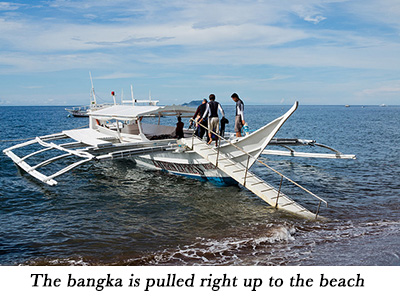 At North Dauin, I spotted three stark-white mushroom pipefish at the base of a green mushroom coral. When I turned from one pair of ghost pipefish, I often bumped into another just a few feet away. Filament-covered ornate ghost pipefish in shades of red, black and yellow were prevalent, and I also spotted roughsnout, halimeda, and robust ghost pipefish. A couple of juvenile peacock razorfish caught my attention with their long first dorsal fin. Fighting male dragonets with erect golden predorsal fins added drama. Waspfish kept their distance. On this dive, I was impressed with the color variations of painted frogfish: yellow, black, cream, orange, and pink, and a black half-inch juvenile I peered at with my magnifying glass had bright orange dots and blue trim on the fin borders and tiny feet and toes. Every time I saw an orange speck, I would head toward it to see if it was a frogfish. Amazing how many times it was! Such a treasure house of critters on one dive!
At North Dauin, I spotted three stark-white mushroom pipefish at the base of a green mushroom coral. When I turned from one pair of ghost pipefish, I often bumped into another just a few feet away. Filament-covered ornate ghost pipefish in shades of red, black and yellow were prevalent, and I also spotted roughsnout, halimeda, and robust ghost pipefish. A couple of juvenile peacock razorfish caught my attention with their long first dorsal fin. Fighting male dragonets with erect golden predorsal fins added drama. Waspfish kept their distance. On this dive, I was impressed with the color variations of painted frogfish: yellow, black, cream, orange, and pink, and a black half-inch juvenile I peered at with my magnifying glass had bright orange dots and blue trim on the fin borders and tiny feet and toes. Every time I saw an orange speck, I would head toward it to see if it was a frogfish. Amazing how many times it was! Such a treasure house of critters on one dive!
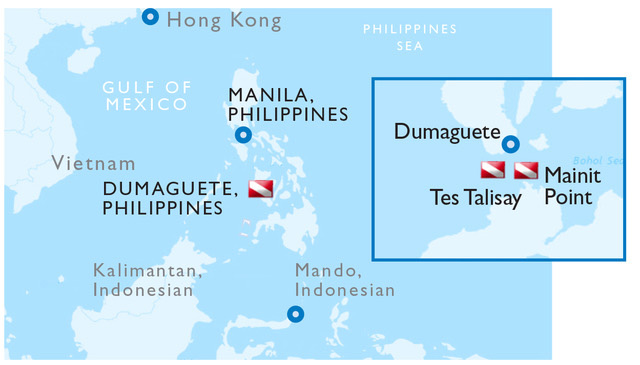
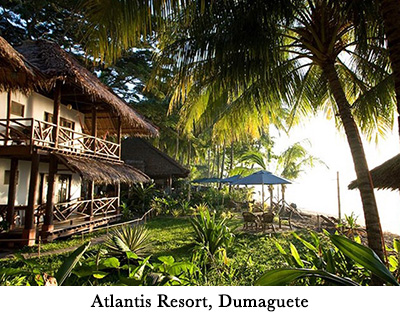 The dive shop -- a large covered
three-sided building -- sits along the
pathway running down to the water, across
from the resort office, meeting room, and
the well-equipped camera room with drying
hoses. The shop, where they held predive
briefings, has a gigantic painted map with
the dive sites numbered. There's plenty
of space to hang wetsuits and BCDs, as
well as individual cubbies. The hardworking
crew loaded all the bangkas (small,
traditional-styled outrigger dive boats,
sometimes called bancas) or the larger (14m) 45-footer). To board, I took a short
walk in knee-deep water to climb an easy
ladder or ramp. At the dive site, it was a
back-roll in, and a ladder climb out after
handing-up my gear. I made nearly all of
the four daily dives (two morning dives,
beginning at 8:30, and two in the afternoon
(we returned between dives for a bathroom break and cookies or muffins) and a
night dive (viewing mandarin fish) was usually an option.
The dive shop -- a large covered
three-sided building -- sits along the
pathway running down to the water, across
from the resort office, meeting room, and
the well-equipped camera room with drying
hoses. The shop, where they held predive
briefings, has a gigantic painted map with
the dive sites numbered. There's plenty
of space to hang wetsuits and BCDs, as
well as individual cubbies. The hardworking
crew loaded all the bangkas (small,
traditional-styled outrigger dive boats,
sometimes called bancas) or the larger (14m) 45-footer). To board, I took a short
walk in knee-deep water to climb an easy
ladder or ramp. At the dive site, it was a
back-roll in, and a ladder climb out after
handing-up my gear. I made nearly all of
the four daily dives (two morning dives,
beginning at 8:30, and two in the afternoon
(we returned between dives for a bathroom break and cookies or muffins) and a
night dive (viewing mandarin fish) was usually an option.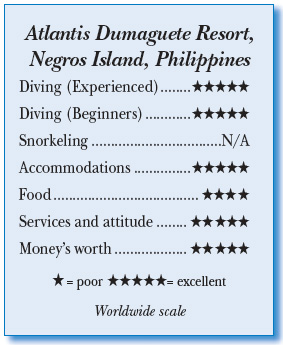 Divemaster Warfi, an observant and helpful kind young man, was a masterful
critter spotter who played traffic cop and had the photographers who wanted
more time with shots go last. With so many critters, there was always another
of interest nearby. However, those unable to overcome old habits queued anyway.
I used a five-inch unobtrusive Paralenz camera for the first time, having never
before taken photos during my thousand-plus dives. Having become frustrated when
I couldn't identify something, I purchased this tube-shaped camera so I could ID
critters later.
Divemaster Warfi, an observant and helpful kind young man, was a masterful
critter spotter who played traffic cop and had the photographers who wanted
more time with shots go last. With so many critters, there was always another
of interest nearby. However, those unable to overcome old habits queued anyway.
I used a five-inch unobtrusive Paralenz camera for the first time, having never
before taken photos during my thousand-plus dives. Having become frustrated when
I couldn't identify something, I purchased this tube-shaped camera so I could ID
critters later.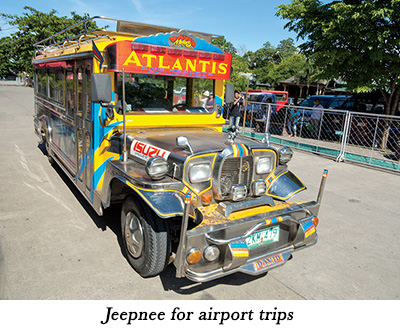 A half hour into our second trip, the engine in their 45-foot (14m) bangka made a strange grating noise and stopped. After an inspection, the crew radioed the resort, and 30 minutes later, we limped into Apo. Another bankga arrived, and after our third dive, the crew tied the two together and we headed home, arriving just an hour later than the usual 3:30.
A half hour into our second trip, the engine in their 45-foot (14m) bangka made a strange grating noise and stopped. After an inspection, the crew radioed the resort, and 30 minutes later, we limped into Apo. Another bankga arrived, and after our third dive, the crew tied the two together and we headed home, arriving just an hour later than the usual 3:30. Divers Compass. My nine-night stay at the resort totaled $3,478, single occupancy, paid with credit card with no fees ... My package included accommodations for a single, all meals, snacks, internet access, five dives a day, one day trip to Apo, and the round trip from Manila to Dumaguete on Cebu Pacific Airlines ... My extras were $1000 of that: nitrox, marine park fees, an extra Apo Island trip, massages, bottles of wine, and three nights at the Belmont Hotel in Manila (just a sky-walk away above crowded lanes of traffic between terminal three, for our domestic Cebu Pacific flights and access to our hotel and a few blocks' walk to good restaurants [and a casino] ... I did not know that tips had to be paid in cash only, and had to borrow from my buddy ... A resort shop sells T-shirts, dive lights, dry bags, etc.
Divers Compass. My nine-night stay at the resort totaled $3,478, single occupancy, paid with credit card with no fees ... My package included accommodations for a single, all meals, snacks, internet access, five dives a day, one day trip to Apo, and the round trip from Manila to Dumaguete on Cebu Pacific Airlines ... My extras were $1000 of that: nitrox, marine park fees, an extra Apo Island trip, massages, bottles of wine, and three nights at the Belmont Hotel in Manila (just a sky-walk away above crowded lanes of traffic between terminal three, for our domestic Cebu Pacific flights and access to our hotel and a few blocks' walk to good restaurants [and a casino] ... I did not know that tips had to be paid in cash only, and had to borrow from my buddy ... A resort shop sells T-shirts, dive lights, dry bags, etc. 